Uncategorized

Posted on
March 21, 2023
4 Min. Read
Author
Diana Muggeridge
Politically Inspired Steps to Help CEOs Prepare for High-Pressure Moments
Corporate lessons inspired by this year’s congressional speaker vote
People across the United States were captivated at the start of the new year by the spectacle in Washington around the election of Kevin McCarthy as Speaker of the House. Throughout the high-profile vote, onlookers saw everything from elected officials taking steps to govern on behalf of the American people, poking fun at their colleagues, and certainly, taking opportunities to raise their own political profiles.
By and large, the operations of corporate board rooms are much more purposeful than what was on display in the Congressional Chamber. But even this hyper-politicized event can teach business executives about how to lead through high-pressure situations.
There are clear parallels between the roles of elected officials and CEOs, showing why the two can borrow from each other’s playbook. For starters, both need to navigate the interests of a broad range of stakeholders. For politicians, it may be political opponents, members of their own party, constituents, or community partners. Executives in turn are managing the needs and expectations of their investors, customers, business partners, employees, and government officials. The public has always entrusted politicians to serve society writ large, and increasingly, that’s been an expectation of business leaders, too.
Both sets of leaders are also doing their jobs under a microscope. Whether their every move is being cast via C-SPAN and analyzed on Twitter or dissected on Squawk Box, leaders are forced to manage issues much more publicly than ever.
Purple Strategies was born of this idea that companies were finding themselves in more dynamic and campaign-like environments and that by bringing perspective and campaign-inspired strategies from the blue and red sides of the political aisle, we could help them navigate that new world order. Today, we help companies and executives every day doing just that, applying diverse perspectives and the principles of politics to help solve complex issues and drive businesses forward.
Here are five actions CEOs can take to prepare for their own high-pressure moments:
(1) Codify your party platform.
High-functioning political operations have a clear party platform that guides candidates’ policy priorities and campaigns. The same principle is true for companies. Building consensus and working through thorny challenges relies on having a solid foundation of the mission, values, and goals that undergird an organization and are greater than any one individual.
(2) Be authentic and purposeful.
Strong leaders can adapt when situations require but are steadfast when it comes to their priorities and core identity. At Purple, we work with leaders to build an executive framework that helps them stay true to these qualities, regardless of the situation. Central to each framework is an executive identity or persona that’s based on a thorough landscape review and becomes an authentic, differentiating, and aspirational characterization of that leader’s style. The framework also includes pillars outlining the themes and topics that the leader wants to keep in-focus. Especially in high-pressure situations, executives turn to their frameworks to ensure they act in a way that’s on-strategy and true to their leadership.
(3) Execute a campaign-inspired activation plan.
Much like being a member of Congress, advancing priorities, building coalitions, and getting ahead of issues before they become a problem all come with the job of CEO. What’s different is corporations don’t have an election day, which can lead to no or slow action by companies on emerging issues. That’s why crafting a plan to consistently engage important stakeholders, credibly act on priorities, and respond to headwinds is so important. Advance planning around these factors becomes an antidote to inaction and helps executives get ahead of roadblocks to their agenda.
(4) Conduct scenario planning.
Scenario plans are an essential part of any political campaign and business plan, and they should be part of every CEO thought leadership plan too. Taking time well in advance to anticipate scenarios the leader could face and planning the messaging and contingencies to use, if needed, helps streamline decision-making and avoid costly missteps.
(5) Prioritize communications training.
Across the public and private sector, the most effective persuasive speakers are so compelling because they practice. Beyond regular traditional media trainings, politicians also spend hours in debate practice and receiving coaching on how to clearly drive a message across formats. Applying these same tactics with executives works seamlessly to help them also communicate in a way that’s engaging, memorable, and in support of their business goals. Amazon Board Member and Former PepsiCo CEO Indra Nooyi said, “You cannot overinvest in communication skills…If you cannot simplify a message and communicate it compellingly, believe me, you cannot get the masses to follow you.” CEOs’ schedules are notoriously busy, but making time to sharpen how they communicate is worth it given the stakes.
As much of a circus that politics can be, there’s a great deal CEOs can learn from it. Read more about how Purple Strategies helps companies and their leaders manage these new political realities.
By Diana Muggeridge | Director
This article first appeared in The Leadership Issue (page 36-37) of The CEO Forum Group quarterly magazine.

Posted on
March 17, 2023
2 Min. Read
Author
Purple Strategies
Purple Strategies Brings in Angela R. Bundrant as Head of Brand
The seasoned C-suite and marketing executive steps into the newly created role in support of the firm’s rapid growth.
Purple Strategies has welcomed veteran media and marketing executive Angela R. Bundrant as head of brand and business development. In her new role, Angela will focus on Purple’s overall brand strategy and positioning and ensuring leading corporations and executives are able to connect with the full complement of Purple offerings as an unparalleled corporate strategy and reputation management firm.
“Clients invite our Purple strategists into the C-suite with them as partners in moments of change – to anticipate the challenges and opportunities to come, to navigate the issues and crises of now, and to compel the changes that shape the future,” said Steve McMahon, Purple Strategies CEO. “The pace of that change has never been faster, and the scale of needed change has never been greater, which made this the right moment to create this role for Purple Strategies and to bring a brand strategist of Angela’s caliber in as a leader at the firm.”
Angela joins the leading strategy and reputation management firm from her most recent role as CEO of PlayersTV, a sports and lifestyle entertainment network for athletes to tell their stories and connect with fans. Prior to that, for eight years Angela was SVP, Marketing and PR, with REVOLT Media, instrumental in the launch of the Black-owned multiplatform music and culture content provider founded by Sean “Diddy” Combs.
Angela’s distinguished career also includes content and partnership marketing roles at Sony Pictures Television, FOX Broadcasting, Turner Broadcasting, and Lintas: Campbell-Ewald, an IPG company.
“A core strength of Purple is our ability to put people from entirely different professional backgrounds together — from politics, campaigns, media, research, advertising, agency, academia, corporations — to develop creative solutions and find new opportunity,” said Kristen Morgante, Purple Strategies managing partner. “As we work to deepen and strengthen our identity as a Category of One, Angela’s experience as both a seasoned C-level executive and as a strategic leader in an unexpected category is an inspiring and uniquely Purple infusion of talent.”
Angela is a graduate of Syracuse University, recognized by the S.I. Newhouse School as a distinguished alumnus and currently is a member of the Dean’s Advisory Board. She has completed executive education programs at Stanford University’s Graduate School of Business and UVA’s Darden School of Business.
“What attracted me to Purple Strategies is the firm’s reputation and politically inspired approach in guiding clients through challenges into opportunities,” Angela R. Bundrant said. “From new offerings we have been developing, to our burgeoning advisory board, to our reputation as a destination for top talent from a wide variety of backgrounds, Purple Strategies is at a truly exciting moment in our growth story, and I’m thrilled to be a part of it.”

Posted on
March 15, 2023
3 Min. Read
Author
Marissa Piette
Three Reputational Implications For Corporations Deploying AI
The AI arms race is on. Microsoft’s release of ChatGPT-powered Bing and Google’s rushed preview of Bard is evidence that Pandora’s box is fully open when it comes to bringing generative artificial intelligence (AI) to the masses.
The repercussions of generative AI on business could be staggering. These technologies promise to transform everything from how business gets done to the way we interact with the world. This is the next technology frontier, one with great promise and, as with any frontier, great peril.
And whether you believe in more government regulation of technology or not, we’ve repeatedly seen elected officials struggle to establish rules that govern how we navigate the perils of fast-moving technological advances. Tech leaders are increasingly calling for government action to ensure the responsible evolution of AI.
In this leadership vacuum, companies that use and deploy AI will be held just as accountable for issues as the companies creating the technology. A recent Purple Strategies survey found that expectations for corporate leaders are high:
- 91% of respondents said it was important for leaders to be transparent about their AI strategy and how investments may impact employees, customers and society.
- 90% said it was important for leaders to solve for potential bias and misinformation in their use of AI.
- 90% said it’s as important for leaders to adopt an ethical framework for implementing AI within their corporations.¹
So how can companies protect their reputations while capitalizing on AI’s potential?
There are three key elements that will influence your company’s reputation with critical stakeholders ranging from employees and consumers to investors and policy makers.
(1) Aligning on “rules of the road”
One of the most important considerations for corporate leaders when developing AI strategy isn’t what they will set out to accomplish – because the future is so uncertain – but instead, what lines they won’t cross. Establishing clear guardrails to guide decisions about investment, development, implementation and outcomes of AI can give organizations a language through which they can convey their values and create alignment with skeptical audiences, even in the absence of ethical standards and strong governance models.
Start by setting guidelines that are agreed upon at the highest levels of your organization: leadership and your board of directors. From there, the rules can be communicated out to managers and employees through dedicated updates and trainings. Strong organizational alignment is critical to ensuring that anyone in a position to develop or use AI is clear on when and when not to use it, what the standard operating procedures are for piloting and reviewing AI programs, and how the guidelines will adapt as the technology continues to advance and be adopted more widely.
Vanderbilt University recently found itself in hot water over its use of ChatGPT to compose an email responding to the deadly shooting at Michigan State University. The email, sent by the office of Equity, Diversity and Inclusion (EDI), was criticized for being generic and impersonal. In the absence of “rules of the road” for how to use AI, people will take the technology into their own hands – with potential negative consequences to follow.
(2) Scenario planning to get ahead of negative consequences
The potential risks of AI are immense. Many of these are known: the spread of misinformation, the proliferation of bias and the potential for human jobs to be replaced by computers. Even more are unknown, or are unique to specific groups or industries. Companies need broad, flexible scenario plans that can serve as a guide when something inevitably goes wrong, as well as proactive and reactive issues-management capabilities to manage through negative consequences and crises.
To get started, think about how your organization plans to invest in and use AI. Based on that vision, identify any negative outcomes that could expose the company to risk. How will the risks impact the business? Stakeholder perceptions? Talent? Based on those scenarios, develop action plans for how to address them.
Using the example above, Vanderbilt found itself in a reactive position, facing negative press and angry students and faculty. It issued an apology and temporarily placed two associate deans on leave while they investigated. They found themselves on the back foot in a media firestorm – a cautionary tale for any company or institution starting to embrace the technology.
(3) Engaging leadership with stakeholders who hold your license to operate
Communications best practice advises us to dialogue with influential audiences to understand where they’re coming from and manage perceptions and expectations. It’s no different with AI. Defining your AI story and messages based on your “rules of the road,” talking to critical stakeholders about what you’re doing, understanding shared concerns, and agreeing on how you can partner together will be critical to managing change with your core audiences. To manage stakeholders effectively, begin coaching executives on how to deliver AI-focused messages so they can bring internal and external audiences along on the journey and create confidence in the vision.
When it comes to AI, everyone is building the proverbial bike as they ride it. Engaging with audiences early will show a willingness to engage and put your company in a better position to manage the AI transition as it’s happening.
Marissa Piette is a Senior Director at Purple Strategies.
¹Purple Omnibus Survey (US Informed Public, N=1,000), February 2023

Posted on
February 24, 2023
3 Min. Read
Author
Purple Strategies
CEOs Unleash the Power of the Individual
Three Ideals of Evolving People-First Leadership from The CEO Forum’s Leadership Summit
Purple Strategies is the thought leadership partner of The CEO Forum Group and Transformative CEO Summit series, featuring CEOs of leading companies discussing creative ways to solve today’s most pressing challenges.
When CEOs started coming together in early 2021 for quarterly Transformative CEO Summits, they were at an inflection point in the voyage of pandemic-era leadership.
Forward momentum for many corporate priorities had largely taken a back seat to navigating an unprecedented global crisis for a year, at which point leaders were ready to pivot from health crisis to human connection: their focus, to steady the ship for their employees and communities in the violent wake of the pandemic’s upheaval of everyday and work life.
The next inflection point came several months later, when gathered CEOs discussed their collective efforts to build better workplaces post-pandemic: the ship was now mostly steady and needed to be strengthened and fortified for the new course that had been set based on the experiences of the crisis.
When CEOs met at the end of 2022, it became clear through their dialogue that a new inflection point has been reached: the expectation that business is once again full-speed ahead, and that achieving this pace will require each and every person to pull in the same direction. And it’s up to CEOs to harness the power and potential of each of those team members.
The following ideals are top of mind for CEOs as their organizations seek to unleash the power of the individuals within them as they continue to chart their course over the coming months.
Ideal #1: Hierarchy gives way to humanity.
Transformative CEOs are flattening their organizations, not necessarily by removing levels needed to manage and function but rather by fostering a culture that allows for the democratization of ideas. They are leaving titles at the door of meetings, allowing for more junior team members to speak up and push ideas forward in a way that fosters innovation and ensures consideration of a diversity of perspectives. They see that when unhelpful or unnecessary structure falls away, individual contributions can expand and decision-making can happen more quickly. In place of that hierarchy, CEOs say, it’s going to require more thought on the part of executives to create the optimal experience to benefit both employees and company productivity.
Ideal #2: Purpose is planful and personal.
Transformative CEOs are looking at purpose through a newer lens as they seek to motivate their teams to stay, to align and to push forward. Historically the company purpose held employees from the same communities together around some shared experiences and frames of reference and to the local employer. In today’s environment more than ever before, the world – and the work experience – are completely portable. With working from home and employer-switching the norm, affinity and loyalty to organizations no longer exists as an anchor in the way it once did. So CEOs must articulate the company’s purpose in such a way that each employee is able to see clearly their own personal alignment with it and contribution to it. This demands that CEOs be more purpose-driven and has the capability of energizing their workforce in the face of continuous change.
Ideal #3: Executive access fosters authenticity and accountability.
As they look at unlocking the power of individuals on their teams, Transformative CEOs are learning the limits and lanes for using their own influence as chief executives, as well. The direct connection they can make with internal and external audiences by leveraging technology is powerful. New tools for communicating and connecting give CEOs an opportunity to have more impact and personal connections at scale and 1:1, but that comes with additional risk that must be managed. One repeated message is no longer enough — today, it feels scripted. CEO communications must be both localized and personalized, and given to others to cascade and further localize and personalize. Authentic, real-time communication can create more meaning and connection between an executive and key audiences, but also more opportunities to depart from planned messaging and into unplanned topic areas. The greater window available today into the leadership of CEOs makes all things visible and calls for high-character leadership. On today’s CEO stage, Transformative CEOs speak truth with compassion, surround themselves with people of high character, take responsibility for their actions and decisions, and are transparent when they fall short.
While it’s unclear what the next inflection point will be for CEOs at the helm of corporations during this time of continued rapid change, it’s unlikely the power of the individual will wane anytime soon, if ever. Transformative CEOs are watching closely and evolving their approaches to be sure that the individuals they work so hard to attract, retain, develop and grow are given every opportunity to unleash their full potential.

Posted on
January 23, 2023
1 Min. Read
Author
Purple Strategies
Purple Joins George Mason Coach Kim English in Coaches vs. Cancer ‘Suits and Sneakers’ Week
Purple co-founder and CEO Steve McMahon and Kim English, head coach of George Mason University men’s basketball, have teamed up for the American Cancer Society’s “Set the Screen” effort to encourage a return to recommended cancer screening.
“The fact that cancer screenings dropped by more than 90% during the pandemic was a sobering statistic for Kim [English] and me to learn,” Steve McMahon said. “Every one of us at Purple has a personal connection to cancer, as do Kim and his team and everyone in our community. We all know decreased and delayed cancer diagnoses and treatments will result in far too many negative outcomes for far too many people and families. I’m honored that Kim asked me and our Purple team to join him in this effort to encourage screenings, and we’re proud to be with him, George Mason, the American Cancer Society and all those on this mission to end cancer.”
Coaches vs. Cancer (CvC) is a nationwide movement created 30 years ago that unites coaches across the country, along with partner CEOs in their communities, to raise funds and awareness about the fight against cancer and promote the American Cancer Society as a source of inspiration and hope for those facing cancer. This year during CvC’s Suits and Sneakers® Week (Jan. 23-29), coaches, companies, CEOs and health providers are joining together for a Set the Screen campaign, designed to call attention to the critical importance of cancer screening.
For more information on cancer screenings, and to join coaches and their partner CEOs in the fight against cancer, visit coaches.cancer.org.

Posted on
December 7, 2022
2 Min. Read
Author
Purple Strategies
Donna Brazile Joins Purple
Purple Strategies welcomes veteran political strategist, New York Times bestselling author and Washington icon Donna Brazile as a senior advisor.
“CEOs are seeing the political and social issues of the day playing out not just in the society in which they operate but also among investors, activists, NGOs, and increasingly, within their own walls among their employees. And they are seeking help from those who have the sophistication, experience, and judgment to advise them in navigating this changing dynamic. Donna Brazile is exactly the kind of seasoned thought partner a smart executive wants to have in their corner,” said Steve McMahon, Purple co-founder and CEO. “The perspective and wise counsel Donna brings, and the reputation she has earned within both the Beltway and boardrooms, will be a meaningful addition to our Purple roster and to our clients.”
Donna is a veteran political strategist, New York Times bestselling author, chair of the J. William Fulbright Foreign Scholarship Board, and sought-after Emmy- and Peabody-award-winning media contributor to such outlets as ABC News, USA Today and TheGrio. She previously served as interim Chair of the Democratic National Committee and of the DNC’s Voting Rights Institute. Donna was the first Black American to serve as the manager of a major-party presidential campaign, running the campaign of Vice President Al Gore in 2000. She serves as an adjunct professor in the Women and Gender Studies Department at Georgetown University and served as the King Endowed Chair in Public Policy at Howard University and as a fellow at the Institute of Politics at Harvard Kennedy School. She has lectured at nearly 250 colleges and universities on diversity, equity and inclusion; women in leadership; and restoring civility in American politics.
“Steve and I both consider ourselves lucky to count Donna as a longtime friend and we’re excited we can finally paint her Purple!” said Alex Castellanos, Purple co-founder and chairman. “Donna is one of the finest human beings I know. I have enjoyed time side by side at podiums and in television studios – at first by chance, then as pundits, and now intentionally because we choose to. Working together reminds us how much strength and clarity can come from approaching any topic or issue from different perspectives. That idea has been at the very heart of Purple since we began, and we’re proud to have Donna with us advancing that ‘Purple’ approach moving forward.”
“I couldn’t be happier about joining the team at Purple,” Donna Brazile said. “Alex and Steve are great friends from way back. Just as important, they are both consummate and dedicated professionals who have built something incredibly special with Purple. I very much look forward to spending time and making a difference with all of the great people at Purple.”
Donna is the second senior advisor Purple has added to the team this year. David Bickerton, seasoned communications, advocacy and corporate reputation leader and visiting fellow at the University of Oxford, joined the firm as a senior advisor earlier in 2022.

Posted on
October 13, 2022
4 Min. Read
Author
Roberta Hatchett
Diverse Perspectives in Issue Management Bring the Unseen to the Surface
A deeper audience understanding is needed to navigate crisis and corporate reputation
By Roberta Hatchett, Purple Senior Director
Independent feminine care company Honey Pot reached $6.4M in revenue in 2021 and holds Black American women as one of its primary audiences. Over the summer, Honey Pot worked through a labeling and communications issue that left it on the edge of irreparable brand damage. In short, the company changed preservative ingredients that called into question its organic certification status.
An ingredient reformulation coupled with a lack of communication is a serious matter for any hygiene company to navigate, and it would be easy to approach the problem as one of packaging and disclosure. However, a more consequential issue was below the surface – rooted in a deeper understanding of the audience – that executives can learn from.
What We See
What was deserving of attention and immediately understood by the Black community and those who understand this audience was the potential for a different type of fear and resentment unrelated to product labeling. This fear comes from the decades-long history of Black-owned personal care companies being acquired by larger corporations that disengage, if not ignore entirely, their long-time customer base. Because of that pattern, if a Black-owned company makes a major shift (intentional or unintentional), its core audience assumes that it’s sold the business and receives the message it’s sold out its customers by turning over the reins to majority-white corporations.


What It Means
Some communities recognize this issue immediately, though most don’t. Having a diverse set of perspectives assessing a challenge will make or break a company’s corporate reputation. Because, even with consumer data and insights in hand, if the right mix of people aren’t in the room, this is the kind of nuanced issue that can be missed. If Honey Pot had treated this issue as it appeared on the surface – as an ingredient issue – it would have failed to address a much deeper concern of its loyal customers.
CEO Beatrice Dixon held both concerns with equal regard when she addressed her social media audience in an impromptu statement within a day of the backlash. She validated the audience’s feelings and quickly confirmed that her company had not been sold.
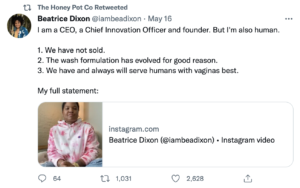
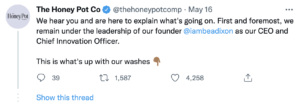
How We Got Here
Historically, most large corporations have neither understood nor done enough work to understand the needs of minority customers. In the delicate space of personal and hair care, many Black-owned businesses looked to the great Madam CJ Walker as the prototype. She filled a huge need and became wildly financially successful in the process. And although her company remained family-owned until it ceased operations in 1981, it was purchased by Sundial Brands in 2013. Shea Moisture – a beloved haircare brand with a large following among Black women – was sold to Unilever by way of Sundial Brands in 2017. Carol’s Daughter, another Black hair care line, had a valuation of $27 million at the time of its sale to L’Oreal in 2014. With each acquisition, the products and packaging changed, the marketing and communications changed, and the face of the company, i.e., the brand image, changed.

These acquisitions resulted in feelings of abandonment among the Black community and left consumers questioning whether wealthy, majority-owned corporations and priorities properly serve the Black community. What had been spaces to celebrate and nurture the unique personal care needs of the Black community were abandoned to serve the preferences of the masses.
Further, despite it being known that “representation matters,” acquiring brands seemed to translate that sentiment only into adding Black and Brown people in advertising. Consumers are savvy and see past these performative measures. They want to know their needs are considered at the production level and that their support (dollars) is benefiting their own communities. For Black consumers, specifically, this is a sentiment born out of a strong sense of community and loyalty – two values that are very important to minority groups. It’s a means of protection and preservation. And for the Black population in the United States, the economics of keeping money within the community psychologically translates to security and safety.
What Companies Can Do About It
The tendency with the acquisition of independent Black personal-care companies is that they become more “mainstream.” Products undergo changes to appeal to wider audiences. Companies also tend to deemphasize the needs of the original customers and instead use them as the basis to attract more mass customers. This leads that customer base to feel as if their patronage isn’t enough or is unimportant.
There are several actions corporations could take that – if authentic and not performative – could help to alleviate this consumer sentiment and position themselves as an extension and celebration of the community rather than an opportunity to change it.
(1) Audience insight. In the early stages of acquisition, companies would be wise to spend more time researching and understanding the existing customer base. Why are they the primary audience? What do they care about? What is their share of revenue contributed across the brands? How can we retain them as a customer?
(2) Communications and marketing strategy. When developing both internal and external communications, carefully consider how the new company is brought into the portfolio of brands. Is it given appropriate status and urgency, or is it shown a less-than-enthusiastic introduction? Even if the fanfare would be less than that of a larger company for financial reasons, be mindful that the perception may be that’s because it’s a minority-owned company. Externally, is the marketing of the new brand inclusive and done so in a way that instills trust? Is there open communication and opportunities for proactive growth? Customers are aware and generally distrustful of any change in a product they’ve grown to know and love. Taking care can go a long way in maintaining that relationship. In either case, authenticity and consistency is paramount.
(3) Product and brand planning. Long-term, how is the brand being managed? Are there resources in place to track how the brand is received by previous and newer audiences? During product development post-merger, how is the company ensuring the product will be the same, if not better, after acquiring the smaller BIPOC-owned business? Are products being further developed with the previous/existing customer in mind, not just with the goal of getting a mainstream audience to expand their brand loyalty?
In this instance, Honey Pot actually had a diverse leadership team and employee base and still initially missed this important and nuanced angle prior to making the ingredient and packaging change. However, CEO Beatrice Dixon was able to quickly understand and react to the sentiment from her customer base. Deep knowledge of her audience and being a part of their community allowed her to quickly correct the mistake rather than ignoring, doubling down, or making matters worse – an incredibly important characteristic for a leadership team.
The first step in making change is being aware. And awareness expands when situations and challenges have input from many different angles and perspectives. All this reinforces the importance of the goal and intention of DEI efforts: Having a diverse set of eyes and ears at every level and corner of an organization – including not just BIPOC customers and employees but also taking holistic, deliberate, and sustainable actions that impact an entire organization from its business leadership to product and marketing – drives better business outcomes.
Roberta Hatchett is a consumer marketing expert and leader with experience spanning ad agencies as well as public and private companies. A senior director at Purple working in digital transformation, she has expertise in messaging and creative integration, digital and social media strategy, and content creation.
Reference and Further Reading

Posted on
September 20, 2022
4 Min. Read
Author
Purple Strategies
CEOs Foster the Dynamic Pull at the Heart of Breakthrough Innovation
Three Tensions That Emerged from The CEO Forum’s Latest CEO Summit
Purple Strategies is the thought leadership and polling partner of The CEO Forum Group and Transformative CEO Summit. The CEO Forum convened its sixth quarterly Transformative CEO Summit on June 21, 2022, featuring many CEOs of leading companies discussing creative ways to solve today’s most pressing challenges.
Charged with fostering breakthrough innovation for their organizations amidst an ongoing pandemic and a range of other global stressors, CEOs at the June Transformative CEO Summit shared their experience harnessing a force core to building a culture of innovation: tension.
Developing an innovation culture is a multi-faceted and complex process, these leaders agreed, requiring a dynamic of healthy tension. Moving too fast can overwhelm an organization’s capacity for producing an innovative product or idea, for example, and moving too slow can render even the best idea obsolete. Acknowledging the conditions required for breakthrough innovation, Transformative CEO Summit participants highlighted three key tensions critical for leaders to fine-tune and foster.
Tension #1: Rewarding Success and Welcoming Failure
Employee behaviors and motivations are a key driver of an organization’s culture of innovation. For CEOs to develop a sustainable environment in which their employees continually generate new ideas or improve upon existing processes, leaders must balance rewarding breakthroughs in innovation while welcoming – if not encouraging – failure.
Rewarding Success
Transformative CEOs celebrate innovative ideas at all levels, not just the ones with the largest impact to a company’s P&L. They build a culture of innovation that pervades the entire company rather than making innovation the purview of just one product development team or a single innovation-focused business unit. Small improvements in efficiencies or solutions to long-standing issues start with those employees on the ground feeling empowered to innovate without asking permission. By proactively engineering and rewarding a diversity of thinking and ultimately results, CEOs can encourage and celebrate innovation happening throughout their organization. And everyone has a chance of being rewarded.
Welcoming Failure
Focusing only on rewarding innovation successes can have unintended consequences of employees feeling pressured to inflate their results or hide serious complications and obscures the reality that trying new ideas is fraught with false starts, test drives, and at times, outright failures. Transformative CEOs openly acknowledge that experimentation that does not always (or at first) yield the desired end result. This gives employee innovators a safe space to be creative as well as fosters the development of flexible processes and technologies that enable people to pivot, connect the dots, and improvise.

Tension #2: Having Patience and Moving Fast
While a culture of innovation is one in which company leaders and their employees never stop developing new ideas, breakthrough innovation comes when companies optimize the tension between moving quickly and waiting for the right moment. Transformative CEOs balance both short-term and long-term innovation goals, driving urgency around near-term opportunities in which timeliness is critical to success, while also finding the space, time and resources for longer-term investments to develop.
Having Patience
Transformative CEOs pace their organization’s progress while pursuing innovation. For example, executives in the Supply Chain Agility and Health workgroup discussed the trade-off of going after incremental improvements and so-called low-hanging fruit, noting that when organizations commit resources to quick innovation wins for short-term gain, they need to carefully consider their readiness and capability to also make investments in the types of longer-term projects and innovation that can lead to structural improvements and transformative ideas. In agreement, several summit participants shared how they directed their organizations to take advantage of temporary COVID-19 shutdowns to rethink and rebuild entire aspects of their business.

Moving Fast
Patience may be a virtue when it comes to innovation, but Transformative CEOs continually face the tension of needing to act, fast, to avoid losing out on important business opportunities, potential hires, and losing out to the competition. Summit attendees credited the role of data in enabling them to respond to change quickly, and to fuel rapid innovation when needed. Transformative CEOs at the summit stressed the importance of using all of the data leaders have at their fingertips to better attract customers, appeal to key stakeholders, meet employee needs, and experiment with products and services to quickly modernize and/or bring new offerings to market.
Tension #3: Simplicity and Scalability
Many organizations represented in the Transformative CEO Community are global companies that face tension between keeping things simple and managing the complexity required to scale when meeting multiple and often different stakeholder needs. CEOs need to solve customers’ problems in a quick, intuitive and data-driven way that scales for broader impact, yet manages to feel localized and personalized for each customer.
Simplicity
Transformative CEOs believe that innovation, at its most simple framing, must make things easier for the end user and solve a problem. In their view, priority characteristics of a successful innovation are practical, intuitive and simple. This requires innovators – at the organization, business unit and individual-contributor level – to identify their core value proposition and commit to that, without tacking on extraneous elements that may become distracting or too complex.

Scalability
The need for businesses to scale can be at odds with the push for simplicity. In the age of customization and personalization, organizations are required to meet the demands of not only all their customer and stakeholder groups but also each of them individually, in order to deliver a meaningful experience to each stakeholder. To scale, Transformative CEOs go beyond simply understanding customer needs and thinking of the customer as a transaction, and take the next step of engaging with the customer as part of the organization’s community. From loyalty programs to virtual reality product launches, companies can create meaningful experiences for each stakeholder. Keeping the idea simple, but scaling a meaningful experience, is the third tension CEOs have to manage as they innovate on processes, products and services.
While Transformative CEOs represent a variety of industries, backgrounds and geographies, most navigate the same three tensions – rewarding success and welcoming failure, having patience and moving fast, and simplicity and scalability – to drive breakthrough innovation in their organizations.

Posted on
August 25, 2022
2 Min. Read
Author
Purple Strategies
Purple Secures Growth Investment from WestView Capital Partners
Full Purple leadership team stays on as rapid growth continues, with new investment to continue developing offering that helps organizations anticipate, navigate and compel change.
Purple is pleased to announce it has welcomed the first strategic investment in the firm’s history, from WestView Capital Partners, a Boston-based private equity firm focused exclusively on middle market growth companies. Purple’s Co-Founders Steve McMahon and Alex Castellanos, Managing Partner Kristen Morgante, and all other Purple partners remain in their roles leading the firm as it continues to rapidly grow on the strength of its offering as strategic reputation partner to Fortune 500 companies and some of the most recognizable brands in the world.
“This investment is both recognition of the success Purple has built and enjoyed thus far as well as fuel for the next phase of our firm’s growth,” Purple CEO Steve McMahon said. “CEOs are feeling pressure from a new mix of stakeholders who expect companies to be their best selves, and it takes the unique blend of political, brand and reputation strategies Purple offers for companies to meet the moment. This is an external partner seeing the strength and relevance of Purple’s work helping organizations and executives address their toughest challenges. And it’s a power source allowing us to leverage their expertise in operationally scaling our firm for the next stage of our journey.”
“We are thrilled to partner with Steve, Kristen, Alex, and the rest of the Purple team,” said Jonathan Hunnicutt, General Partner at WestView. “We seek to invest in pioneering companies and Purple has demonstrated that it is in a category of one with its differentiated strategy, capabilities and approach in the market. The pace of change has never been faster, and it’s clear C-suite executives’ need for a trusted partner like Purple to navigate the issues they are facing has never been greater.”
“Purple is a place and team that some of the largest corporations in the world trust with their future,” Purple Chairman Alex Castellanos said. “This partnership with WestView is a signal to our team members and client partners that Purple remains strongly positioned for continued development of our offering and focused on creating opportunities for our people.”
“In deciding to bring on any investment partner, we knew it needed to feel additive for our clients and our Purple team members and allow us to continue to lead and manage the business in a way that preserves and stays true to what has made Purple special, and we found that partner in the WestView team,” Purple Managing Partner Kristen Morgante said. “They are interested in investing in Purple because they believe our offering is important and unique, they believe in our capacity to achieve even more success, and they believe in the team we’ve built. We’re incredibly excited to have them with us as we write this next chapter for Purple.”

Posted on
June 16, 2022
4 Min. Read
Author
Purple Strategies
CEOs Embrace Expectation to go Beyond Corporate into Societal Leadership
Three Themes from The CEO Forum’s Second Annual Transformative CEO Summit
Purple Strategies is the thought leadership and polling partner of The CEO Forum Group and Transformative CEO Summit. The CEO Forum convened its Second Annual (and fifth quarterly) Transformative CEO Summit on April 21, 2022, featuring many CEOs of leading companies discussing creative ways to solve today’s most pressing challenges.
The story of the first-ever Transformative CEO Summit was about CEOs embracing the pivot from health crisis to human connection as the world emerged from the first year of the pandemic. The thread through discussions among executives at the second annual installment held in April of this year focused on a shift for the CEOs themselves as executives embraced growing expectations from stakeholders that they take on even more of the mantle of societal leadership.
The public expectation for business leaders to play a role in areas outside of their business interests is not new. But the pressure for business leaders to step into broader societal issues appears to be intensifying. Contending with the third year of COVID, along with an economy-shaking war in Europe, continued global supply chain disruptions, and more tipping-point moments at home around issues such as reproductive health, guns, justice and democracy, CEOs find themselves more often in the spotlight and more frequently called on to be a part of the solution to some of the most challenging issues facing society.
The following areas are at the forefront for CEOs as they lean into those growing societal expectations – what the Summit theme articulates as “creating a new world ecosystem” – and what might come next for CEOs.
(1) Leading society through workforce transformation.
Even in the space closest to “home” for executive presence – within the walls of companies – the need for CEO leadership is quickly becoming more expansive. To start, many of those walls are now virtual. Workforce realities have empowered employees to demand more flexibility and sustained hybrid work. How companies treated their workers, and in particular their working parents, became a variable shaping corporate reputation, as internal and external stakeholders watched and evaluated how well corporate America supported its employee base.
Those expectations around flexibility and supporting working parents are just two manifestations of a larger trend CEOs see of employees increasingly driving culture and pushing for clearer corporate purpose. Transformative CEOs aren’t threatened by the activism of their employee base; rather, they are measuring, understanding and harnessing their employees’ purpose and passion and using it to fuel both business success and the company’s ability to have a broader impact on society.
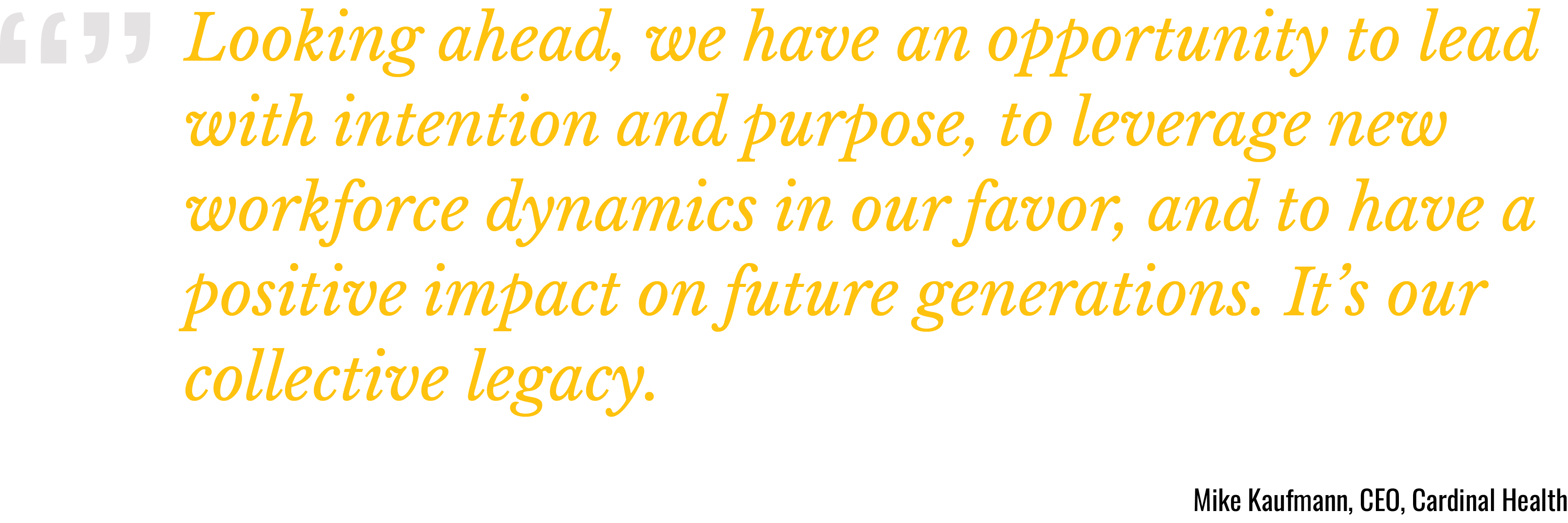
(2) Leading society through interconnected crisis and innovation.
In crisis playbooks of old, CEOs might have been guided through scenarios primarily impacting just the company, its customers, its industry, and the communities in which it operates. The last few years have seen crises become much more expansive, with CEOs being asked to lead in times of crisis through a complicated interconnected web of global health, race, economy and climate, all at once. Transformative CEOs agree that navigating this unprecedented style of crisis demands an unprecedented willingness on their part to flex and to fail. To flex, by throwing out old structures and silos and preconceived notions about what is possible. And to fail, by being open to big new ideas, failing fast and quickly course-correcting – a successful strategy through not only crisis but also innovation.
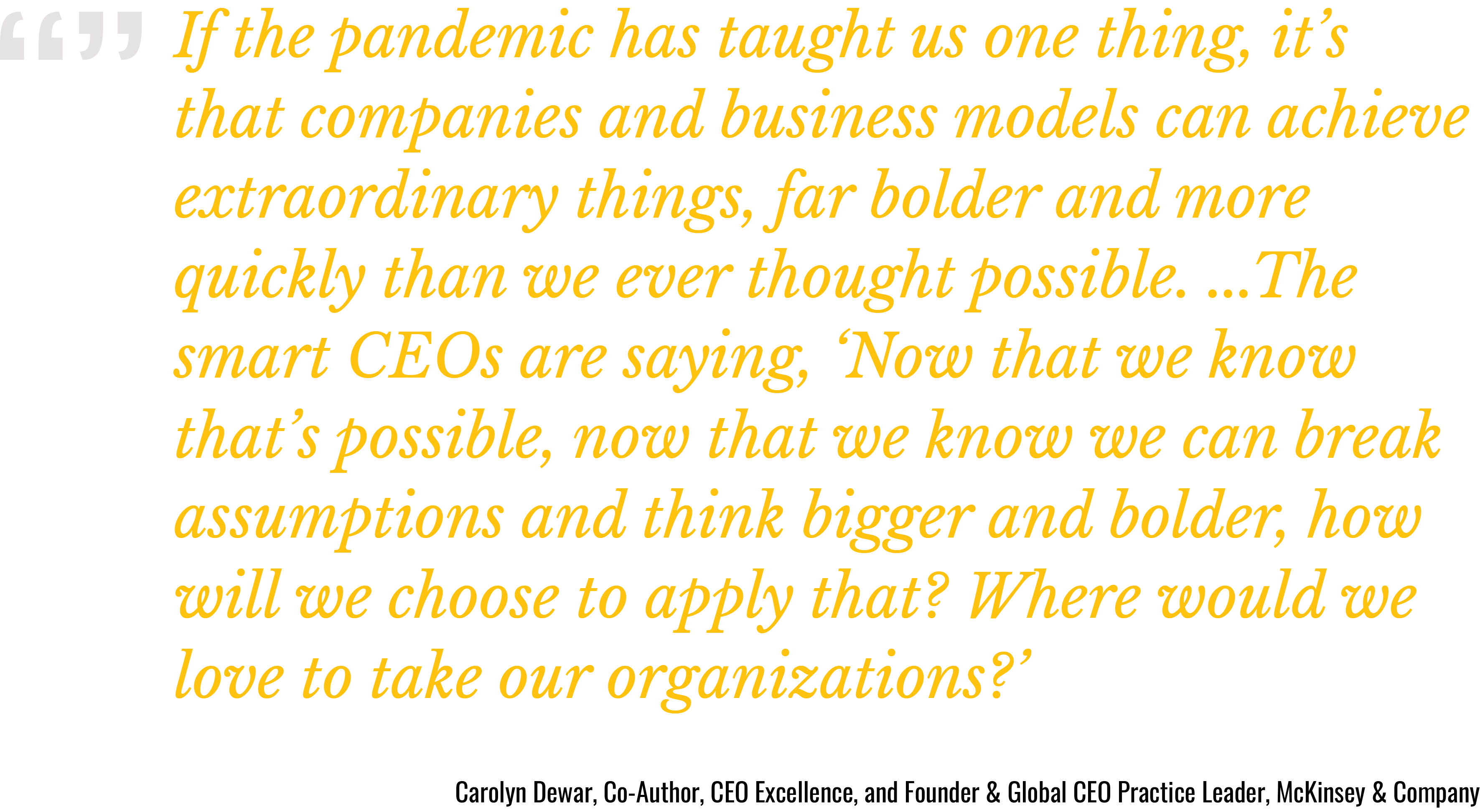
(3) Leading society through social and political issue discourse.
Americans increasingly expect companies to play a role in speaking out on issues impacting the public and society, while at the same time, more and more executives agree they have some responsibility to respond to major societal or geopolitical events. Purple Strategies polling of Transformative CEOs during the Summit revealed 3 in 4 feel prepared to weigh in or respond to societal issues on behalf of their companies. CEOs are also quick to point out that global impact doesn’t require action on a global scale: Authentic investment and commitment in a local community can build to influence the global community. As CEOs evaluate their purpose and responsibilities on these kinds of issues, Summit participants encouraged one another to be intentional about where, when and how they are using their voice – and then backing it up with actions.
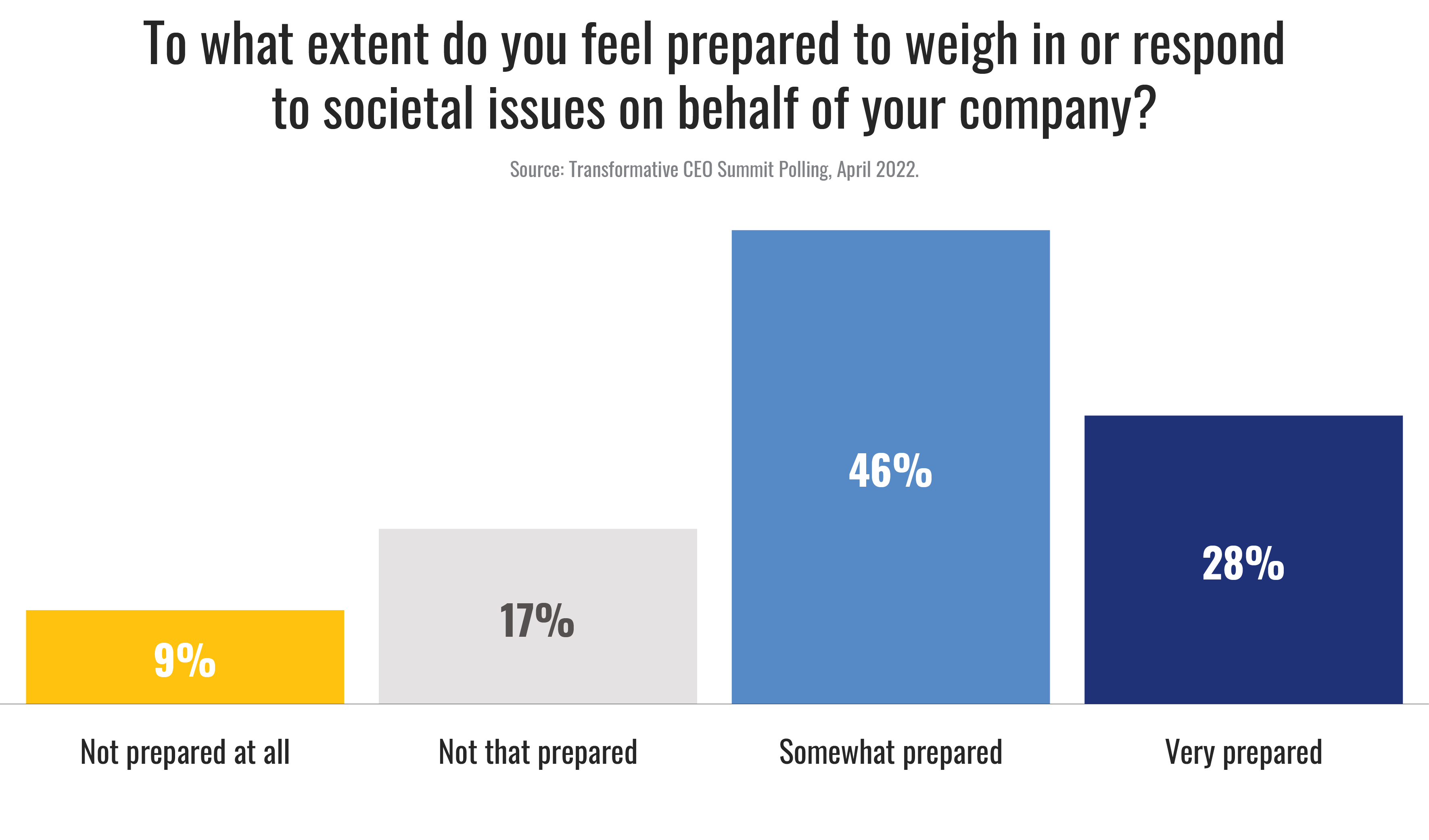
While the growing remit of the CEO looks poised to continue into even more expansive societal leadership expectations, Transformative CEOs are ready for the challenge. Summit participants were united in optimism that CEOs are prepared to meet this moment of new opportunity and engage in shaping the global ecosystem that is evolving before our eyes.
 AI and Paradigm Shifts on the Minds of Healthcare CEOs
AI and Paradigm Shifts on the Minds of Healthcare CEOs  Purple Strategies Elevates Three To Partnership Group
Purple Strategies Elevates Three To Partnership Group